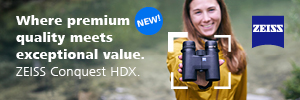as I always said, I do the review with my eyes then take photo as reference. so I didn't let photo to influence my test reults.I would like to say again how much I do enjoy your bino opinions and posts. I do find that many posts (not just yours) with photos highlighting, in this case CA very misleading for multiple reasons. I’m out right now with the 32 EL and UV trying to duplicate visually what your photos are showing, and it’s just not happening. Later on we’re going to get a few other observers together with some of the others mentioned in this discussion and see if there is some kind of consensus on a few characteristics. In the past we’ve taken pictures (unprofessionally) with different cell phones and have noticed more times than not the differences the that the device is imparting. Seeing what I’m looking at through the binoculars right now with my eyes is dramatically different than the photos here. It’s just my opinion that the optical train of the photo equipment taking the picture is not reliable to real time observing. I’d think each photo and each device taking a photo could be similar ( if not less accurate) than the individual differences people observers, in this case CA which varies from person to person. Similar things can be said for glare , our resident bino expert (and my friend 😀) sees glare in every binocular, heck he even sees glare without binoculars 🤭.
fankly, I see CA more u. real view then at the photo.
and of course, photo taken at diverse light situation muse be diffrent, but if two binoculars photo are taken at closest to same condition (30 ~ 60sec differ)
It is likely to represent at least the win and loses of the specific part of the binocular.
(expept brightensee unless it is taken at nigh time with same camera settings.)
My opinion stays put. Photo never can's say all the thing of the bino. but if taken in serious setting of the photographer it at least can be a breif reference of the bino. expecailly some optical parts such as distortion, FOV
And it is better then just saying things like 'I see this bino and I like it'









